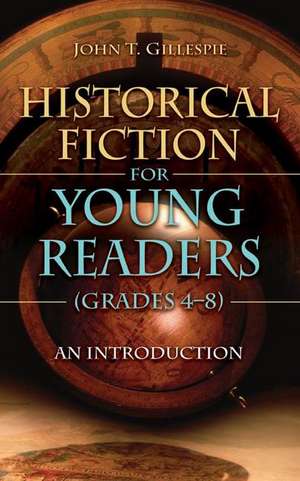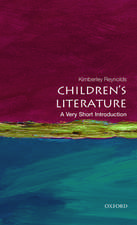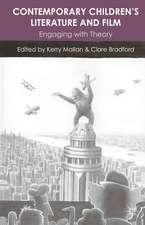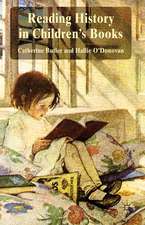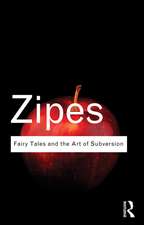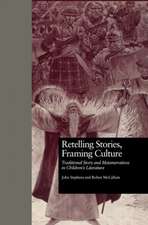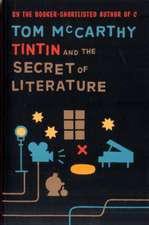Historical Fiction for Young Readers (Grades 4-8): An Introduction: Children's and Young Adult Literature Reference
Autor John T. Gillespieen Limba Engleză Hardback – 29 oct 2008 – vârsta până la 17 ani
Din seria Children's and Young Adult Literature Reference
- 28%
 Preț: 541.41 lei
Preț: 541.41 lei - 27%
 Preț: 381.55 lei
Preț: 381.55 lei - 15%
 Preț: 344.53 lei
Preț: 344.53 lei - 22%
 Preț: 259.42 lei
Preț: 259.42 lei - 27%
 Preț: 349.04 lei
Preț: 349.04 lei - 26%
 Preț: 451.32 lei
Preț: 451.32 lei - 23%
 Preț: 367.94 lei
Preț: 367.94 lei - 26%
 Preț: 423.62 lei
Preț: 423.62 lei - 25%
 Preț: 402.32 lei
Preț: 402.32 lei - 23%
 Preț: 344.85 lei
Preț: 344.85 lei - 22%
 Preț: 481.03 lei
Preț: 481.03 lei - 23%
 Preț: 368.36 lei
Preț: 368.36 lei - 18%
 Preț: 354.30 lei
Preț: 354.30 lei - 26%
 Preț: 421.94 lei
Preț: 421.94 lei - 25%
 Preț: 493.40 lei
Preț: 493.40 lei - 22%
 Preț: 497.06 lei
Preț: 497.06 lei - 27%
 Preț: 340.20 lei
Preț: 340.20 lei - 23%
 Preț: 340.20 lei
Preț: 340.20 lei - 34%
 Preț: 342.06 lei
Preț: 342.06 lei - 22%
 Preț: 450.48 lei
Preț: 450.48 lei - 26%
 Preț: 420.24 lei
Preț: 420.24 lei - 27%
 Preț: 351.31 lei
Preț: 351.31 lei - 27%
 Preț: 384.28 lei
Preț: 384.28 lei - 40%
 Preț: 246.08 lei
Preț: 246.08 lei - 36%
 Preț: 527.02 lei
Preț: 527.02 lei - 22%
 Preț: 421.66 lei
Preț: 421.66 lei - 40%
 Preț: 381.99 lei
Preț: 381.99 lei
Preț: 415.61 lei
Preț vechi: 566.39 lei
-27% Nou
Puncte Express: 623
Preț estimativ în valută:
79.52€ • 83.25$ • 65.80£
79.52€ • 83.25$ • 65.80£
Carte tipărită la comandă
Livrare economică 05-19 aprilie
Preluare comenzi: 021 569.72.76
Specificații
ISBN-13: 9781591586210
ISBN-10: 1591586216
Pagini: 504
Dimensiuni: 156 x 235 x 36 mm
Greutate: 0.95 kg
Editura: Bloomsbury Publishing
Colecția Libraries Unlimited
Seria Children's and Young Adult Literature Reference
Locul publicării:New York, United States
ISBN-10: 1591586216
Pagini: 504
Dimensiuni: 156 x 235 x 36 mm
Greutate: 0.95 kg
Editura: Bloomsbury Publishing
Colecția Libraries Unlimited
Seria Children's and Young Adult Literature Reference
Locul publicării:New York, United States
Notă biografică
John T. Gillespie, former Dean and Instructor of Library Science, Long Island University, New York, has authored numerous books in the areas of library management, school libraries, and children's and young adult literature.
Cuprins
Preface1. Introduction and Criteria for Evaluating Historical Ficton2. A Brief History of Historical Fiction for Young Readers in English3. Bringing Young Readers and Books Together4. Europe5. Asia and Oceania6. Africa7. Latin America and Canada8. United StatesAuthor IndexTitle IndexSubject Index
Recenzii
Gillespie has been putting together collections of reviewed and recommended books for many years and teacher-librarians are probably using them as selection tools either in print like this book or as a part of an automated selection system.
Gillespie-author of several readers' advisory books for young readers, among then Classic Teenplots: A Booktalk Guide to Use with Readers Ages 12-18, Libraries Unlimited, (2006)-selects 80 of the best from 15 years. Each entry includes bibliographic information, an introduction, a thorough historical background, a list of characters, a detailed plot synopsis, suggestions for booktalking, and a short discussion of themes and subjects. The historical background and detailed summaries will be especially useful for teachers looking to select texts for classroom use. Librarians should be pleased with the multiple suggestions of passages for booktalking for each title, and the subject, title, and author indexes will help locate books for homework assignments . . . recommended for all school and public library collections.
This book can easily be used by librarians to work with history teachers and is strongly recommended for librarians who purchase historical fiction.
Gillespie (former Dean and instructor, library science, Long Island U.) provides a guidebook to historical fiction for grades 4-8 with the intention of engaging and instructing the age group. Gillespie provides both a brief history of historical fiction for young readers and his criteria for evaluating the books, and gives title listings by first geographic areas and then time period, as appropriate. Information for each title includes publication information, historical background, principal characters and plot synopsis, and passages for discussion. Both a title and subject index are provided.'
Gillespie begins with chapters that suggest the criteria by which fiction, and historical fiction specifically, should be evaluated. He gives a detailed and enlightening look at the development of the genre that serves as a useful guide for building a collection of must-haves or classics. . . . Overall, this is a solid resource for librarians new to the field, or for those looking to update their collections.
Dr. Gillespie gives us another wonderful resource that all librarians who work with the intended audience will definitely need but also want. . . . This is an essential purchase for all elementary/middle school librarians, public librarians and students in graduate classes in library science.
Librarians who work with young people, who do readers advisory and build juvenile collections, will find this work particularly valuable. However, while Gillespie's focus is on librarians, teachers will also find the information here extremely useful. Its layout and historical divisions will assist teachers in finding just the right book to make cross curricular connections with social studies, history, and language arts. Although this work is structured around novels suitable for grades four through eight, teachers of all grades will find this work valuable for its in-depth descriptions of novels that can be used for read alouds or resources for reluctant readers who are outside of the targeted age range. For academic librarians serving education students and juvenile collections this work would be an excellent addition since pre-service teachers preparing lesson plans and studying the field of children's literature will also find value in the outstanding coverage and depth of this work.
Gillespie-author of several readers' advisory books for young readers, among then Classic Teenplots: A Booktalk Guide to Use with Readers Ages 12-18, Libraries Unlimited, (2006)-selects 80 of the best from 15 years. Each entry includes bibliographic information, an introduction, a thorough historical background, a list of characters, a detailed plot synopsis, suggestions for booktalking, and a short discussion of themes and subjects. The historical background and detailed summaries will be especially useful for teachers looking to select texts for classroom use. Librarians should be pleased with the multiple suggestions of passages for booktalking for each title, and the subject, title, and author indexes will help locate books for homework assignments . . . recommended for all school and public library collections.
This book can easily be used by librarians to work with history teachers and is strongly recommended for librarians who purchase historical fiction.
Gillespie (former Dean and instructor, library science, Long Island U.) provides a guidebook to historical fiction for grades 4-8 with the intention of engaging and instructing the age group. Gillespie provides both a brief history of historical fiction for young readers and his criteria for evaluating the books, and gives title listings by first geographic areas and then time period, as appropriate. Information for each title includes publication information, historical background, principal characters and plot synopsis, and passages for discussion. Both a title and subject index are provided.'
Gillespie begins with chapters that suggest the criteria by which fiction, and historical fiction specifically, should be evaluated. He gives a detailed and enlightening look at the development of the genre that serves as a useful guide for building a collection of must-haves or classics. . . . Overall, this is a solid resource for librarians new to the field, or for those looking to update their collections.
Dr. Gillespie gives us another wonderful resource that all librarians who work with the intended audience will definitely need but also want. . . . This is an essential purchase for all elementary/middle school librarians, public librarians and students in graduate classes in library science.
Librarians who work with young people, who do readers advisory and build juvenile collections, will find this work particularly valuable. However, while Gillespie's focus is on librarians, teachers will also find the information here extremely useful. Its layout and historical divisions will assist teachers in finding just the right book to make cross curricular connections with social studies, history, and language arts. Although this work is structured around novels suitable for grades four through eight, teachers of all grades will find this work valuable for its in-depth descriptions of novels that can be used for read alouds or resources for reluctant readers who are outside of the targeted age range. For academic librarians serving education students and juvenile collections this work would be an excellent addition since pre-service teachers preparing lesson plans and studying the field of children's literature will also find value in the outstanding coverage and depth of this work.
